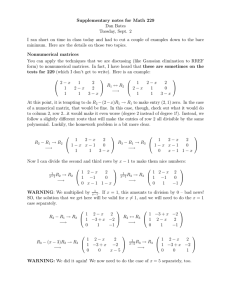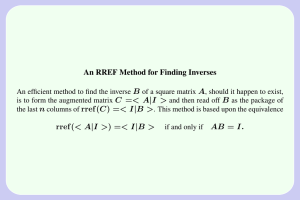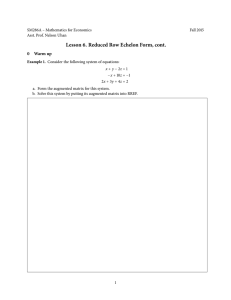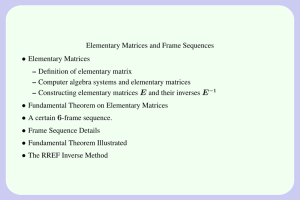Document 11097410
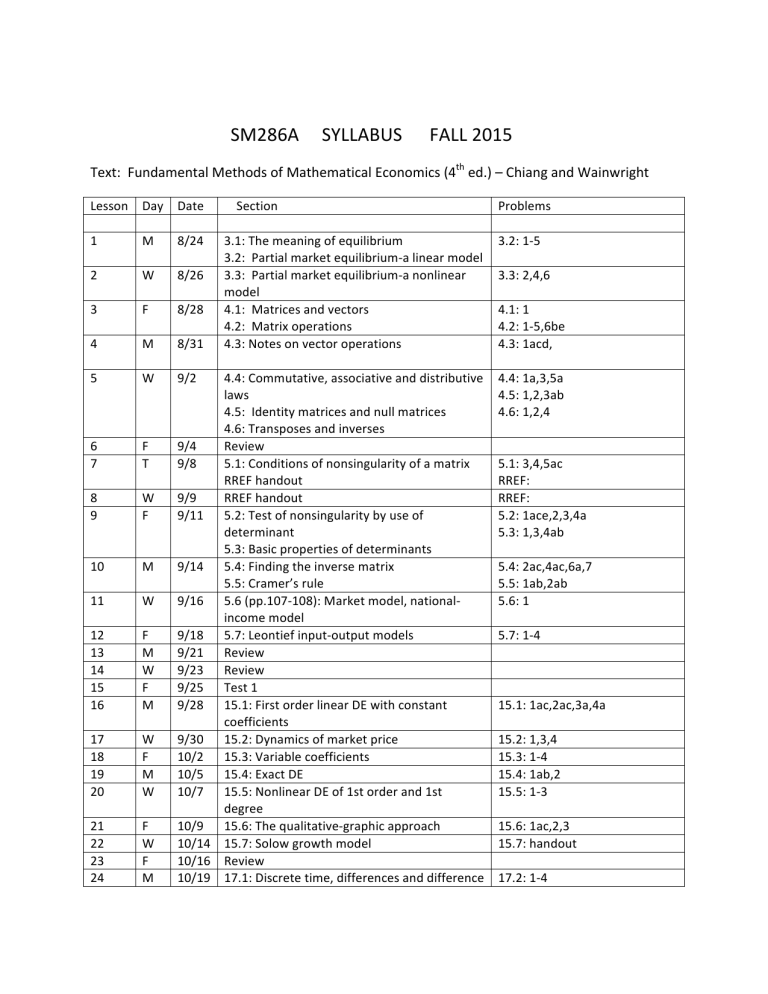
SM286A SYLLABUS FALL 2015
Text: Fundamental Methods of Mathematical Economics (4
th
ed.) – Chiang and Wainwright
Lesson Day Date Section
1
2
M 8/24 3.1: The meaning of equilibrium
3.2: Partial market equilibrium-‐a linear model
W 8/26 3.3: Partial market equilibrium-‐a nonlinear model
3
4
5
6
7
8
9
10
11
12
13
14
15
16
17
18
19
20
21
22
23
24
F
M
8/28
8/31
4.1: Matrices and vectors
4.2: Matrix operations
4.3: Notes on vector operations
W 9/2 4.4: Commutative, associative and distributive laws
4.5: Identity matrices and null matrices
4.6: Transposes and inverses
F 9/4 Review
T 9/8 5.1: Conditions of nonsingularity of a matrix
RREF handout
W 9/9 RREF handout
F 9/11 5.2: Test of nonsingularity by use of determinant
5.3: Basic properties of determinants
M 9/14 5.4: Finding the inverse matrix
5.5: Cramer’s rule
W 9/16 5.6 (pp.107-‐108): Market model, national-‐ income model
F 9/18 5.7: Leontief input-‐output models
M 9/21 Review
W 9/23 Review
F 9/25 Test 1
M 9/28 15.1: First order linear DE with constant coefficients
Problems
3.2: 1-‐5
3.3: 2,4,6
4.1: 1
4.2: 1-‐5,6be
4.3: 1acd,
4.4: 1a,3,5a
4.5: 1,2,3ab
4.6: 1,2,4
5.1: 3,4,5ac
RREF:
RREF:
5.2: 1ace,2,3,4a
5.3: 1,3,4ab
5.4: 2ac,4ac,6a,7
5.5: 1ab,2ab
5.6: 1
5.7: 1-‐4
15.1: 1ac,2ac,3a,4a
W 9/30 15.2: Dynamics of market price
F 10/2 15.3: Variable coefficients
M 10/5 15.4: Exact DE
W 10/7 15.5: Nonlinear DE of 1st order and 1st
15.2: 1,3,4
15.3: 1-‐4
15.4: 1ab,2
15.5: 1-‐3
F 10/9 degree
15.6: The qualitative-‐graphic approach
W 10/14 15.7: Solow growth model
F 10/16 Review
15.6: 1ac,2,3
15.7: handout
M 10/19 17.1: Discrete time, differences and difference 17.2: 1-‐4
25
26
27
28
29
30
31
32
33
34
35
36
37
38
39
40 equations
17.2: Solving a 1st order difference equation
W 10/21 17.3: The dynamic stability of equilibrium
F 10/23 17.4: The cobweb model
M 10/26 Review
W 10/28 Test 2
F 10/30 11.6: Motivating examples :
11.2: Extreme values of a function of two variables
M 11/2 11.3: Determinant review
Quadratic forms, positive/negative definiteness
W 11/4 11.3: Second-‐order conditions, the Hessian
F 11/6 11.4: Generalization to n variables
M 11/9 11.5: Convex and concave functions
Convex sets
F 11/13 11.6: Solving the motivating examples
M 11/16 Review
W 11/18 12.1: Effects of a constraint
12.2: Solving by substitution
F 11/20 12.2: Lagrange multiplier method
Shadow price interpretation of Lagrange multiplier
M 11/23 12.3: Second-‐order conditions, the bordered
Hessian
W 11/25 12.3: Generalizations: n variables and 1 equality constraint, n variables and m equality constraints
M 11/30 12.5: Utility maximization
12.7: Least-‐cost combination of inputs
W 12/2 Review
F 12/4 Review
M 12/7 Test 3
W 12/9 Review
17.3: 1ab,2a,3a
17.4: 2,3
11.2: 1,2
11.3: 1ac,2c
11.3: 3ac,4abe,5abe
11.4: 1-‐4,5a
11.5: 1-‐6
11.6: 1-‐3
12.2: 1-‐3
12.3: 1
12.5: handout
12.7: handout
41
42
43
44
Student Learning Outcomes: Learning Goals and Objectives for Mathematics for Economics (SM286A):
Upon successful completion of this course, students are able to do the following:
1.
2.
3.
4.
Perform basic operations with matrices.
Solve simple equilibrium models in economics using matrix methods.
Apply the theory of first order differential equations and difference equations to analyze growth models in economics.
Apply the theory of constrained optimization to problems involving utility maximization or least-‐cost combination of inputs.
